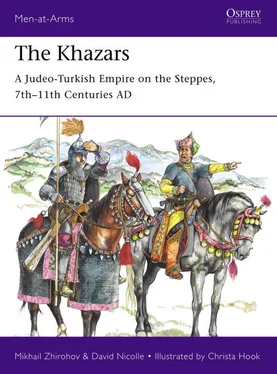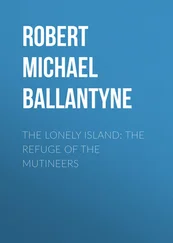D3: Slavic tribal leader, 9th century
In comparison with the Khazars, other Turks and the Magyars, most of the Slav tribes dominated by the Khazar Khaganate had rudimentary military equipment, being rarely rich enough to afford much beyond a spear, shield, and sometimes an axe. As a tribal leader this man has also acquired a battered old Byzantine helmet of iron with broad brow and fore-and-aft bands, a double-edged sword of perhaps central European origin, and a curved dagger. Nevertheless, his woollen tunic is covered in expensive imported silk; it has borders embroidered with a geometric pattern which may have served as a form of tribal identification, and his black cloak is fastened with a gilt brooch.
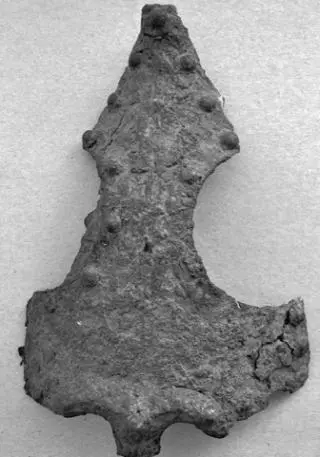
Frontal plate, with part of the ‘eyebrows’ and nasal, from a riveted helmet of the Khazar period found in the Caucasus region; compare with (1) in drawings on here. (Professor Murtazali Gadjiev via Adam Kubik)
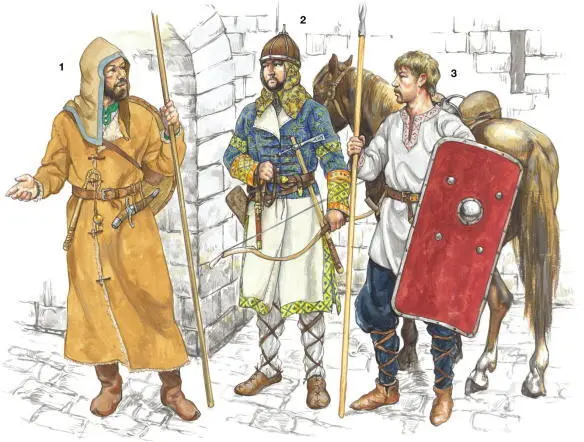
1: Urban militiaman, 8th C
2: Khazar tribesman, 9th C
3: Radmich Slav tribesman, 8th C
E1: Urban militiaman, 8th century
The Khazar state included substantial settled as well as nomadic populations, plus a number of important if small trading towns, mostly in the northern foothills of the Caucasus and on the great rivers which served as highways. It seems that some urban centres had forms of local militia, comparable to those of the Islamic world to the south. This man’s large, relatively stiff felt cap or hood also mirrors that of many peoples south of the Caucasus mountains; with their khanjar fighting knives, spears and large round shields, such men would not have looked out of place in Islamic Iran or Central Asia. However, note that this man also has tucked into his belt a simple form of kisten or war-flail, with a spherical bronze weight at the end of a thickly plaited rawhide strap attached to a wooden handle.
E2: Khazar tribesman on foot with packhorse, 9th century
This tribesman’s helmet is of a light form: a hardened leather bowl with slender vertical iron framing elements, a broader brow-band, and an iron finial. Nevertheless, some aspects of his clothing suggest that he is from a settled community in trading contact with wealthy regions beyond the frontiers of the Khaganate. His (probably mail) aventail is covered with a richly embroidered textile, and his white coat, which opens down the front with only a small overlap, is also covered on torso, sleeves and borders with decorative imported Persian silk. Under the coat he probably wears a short-hemmed and short-sleeved mail shirt. His shoes and the cross-binding around his legs show that he expects to walk more than to ride. His weapons are a bow, a fighting knife, and an axe with a characteristically slender blade balanced by a second projection behind the socket.
E3: Radmich Slav tribesman, 8th century
This ordinary Slav tribesman only has a spear and dagger, while the rectangular shape of his large shield is hypothetical. His clothing is largely of linen; the simple embroidered pattern around the neck and cuffs of his tunic has been tentatively identified with the Radmich tribe, which lived along the upper reaches of the Dnieper river and its tributaries, on the north-western frontier of Khazar territory.

1: Khwarazmian Arsiya cavalryman, 9th–10th Cs
2: Viking raider, 10th C
3: Khazar light cavalryman, 9th C
F1: Khwarazmian cavalryman of Arsiya Guard, 9th–10th centuries
Many of the Khagan’s Muslim Arsiya units originally came from one of the militarily and technologically most sophisticated (as well as one of the wealthiest) regions of Central Asia, and, when settled at the Khazar capital of Atil, they remained a military elite. This man has therefore been given the finest known arms and armour of the eastern provinces of the Islamic Caliphate, including a one-piece steel helmet with silvered stars riveted to the surface, a purely decorative silvered finial and a brow-band decorated in the same manner. The very short nasal bar may have protected the lacing of the deep aventail’s facial flap, which is here shown unlaced. In addition to a long-sleeved mail hauberk under his coat, he wears a steel lamellar cuirass and separate tassets covering the thighs, with alternate rows of the lamellae gilded. His baggy trousers are confined by felt-lined leather gaiters, with upper and lower coloured lines around the whitened surface, and lacing up the inner legs. His double-edged straight sword has a silvered bronze hilt that includes a sleeve which passes outside the throat of the scabbard, and his shield is edged with tufted coloured wool. The khanjar at his right hip was a weapon shared by many peoples of the steppes. His horse (background) has relatively plain modern harness, but the silvered ‘muzzle-bit’ is an item that may have dated from pre-Islamic times.
F2: Viking raider, 10th century
This unfortunate has been hunted down on the banks of the lower Volga in 914. The Scandinavian raiders who became known as Varangians, and who created the first Russian state, were significantly better armed than the indigenous Slavs and Finns who inhabited these areas. Initially their daring and ferocity also enabled them to overawe some Muslim peoples along the shores of the Caspian Sea, but eventually they were expelled by both Muslims and Khazars. The man shown here has been given the mixture of equipment which would come to characterize the Varangians and the armies of early Kievan Rus. Thus the mail hauberk, shield and sword could be seen as Viking, while the segmented helmet and mail aventail might be considered early Russian.
F3: Khazar light cavalryman, 9th century
Not all Khazar cavalrymen were heavily armoured, even during the Khaganate’s period of greatest prosperity. This man only has a long-sleeved mail hauberk plus a shield, sabre and archery equipment. His colourful coat is in the distinctively Turkish double-breasted style, showing contrasting lining and applied woven decorative bands at the edges. The horse’s harness is ornamented in the steppe style, but the snaffle bit lacks vertical psalion bars. Some sources show an additional single strap terminating in a loop attached to the apex of the usual reins; this was probably not just a leading rein, but an aid to controlling the horse when the rider was using both hands to shoot the bow.
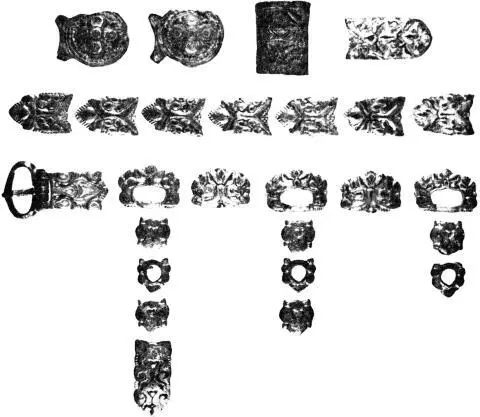
Khazar metal belt fittings from Sarkel, 10th century. (Archive of M Zhirohov)
1: Magyar woman, 10th C
2: Khazar Jewish warrior, 9th C
3: Vyatchian Slav tribesman, 8th–9th Cs
G1: Magyar woman, 10th century
This scene is imagined in the interior of a turf-roofed timber house dug partly below ground level, and heated by a large clay oven. Most information about Magyar female costume comes from the period immediately after the western Magyars migrated from Ukraine across the Carpathian mountains onto the Great Hungarian Plain, but there is little reason to believe that the dress of either men or women had changed significantly during the previous few decades. The costume illustrated is based upon archaeological finds, the limited pictorial sources, and some hints in the written texts. Her elaborate hair decoration consists of large gold discs hanging from open ‘triangles’ at the ends of gold chains attached to her two ‘ponytails’; it is enough to identify her as a woman of wealth and social status.
Читать дальше
